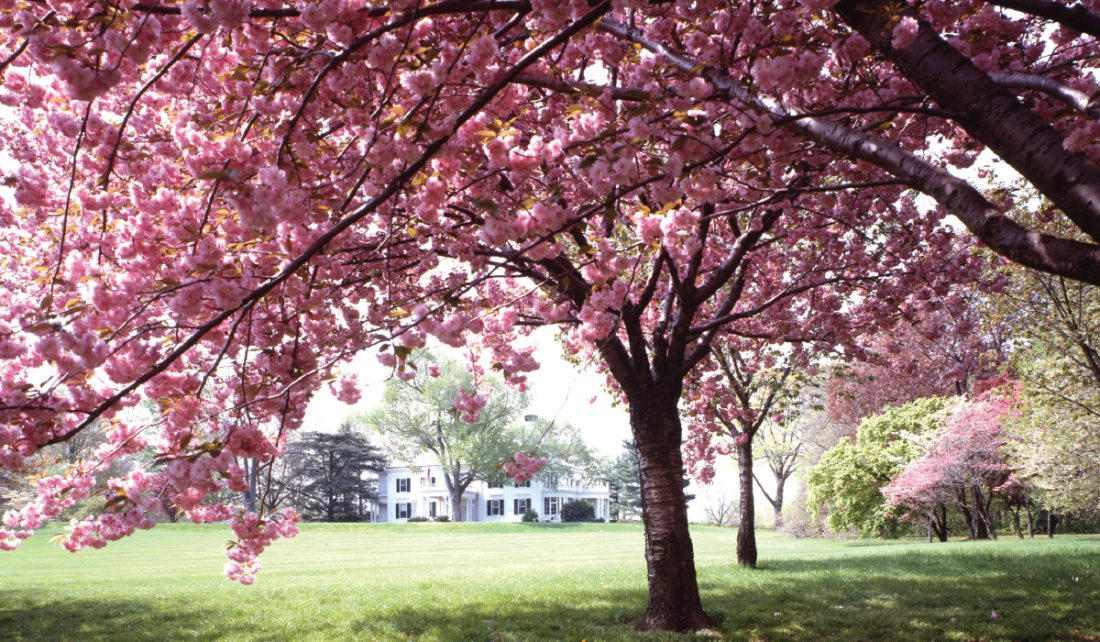March 31, 2020
Spring Flowering Trees
One of the prettiest sights of the gardening year is the show provided by spring flowering trees. Who can resist the frothy pink flowers of the Kwanzan Cherry or the long-lasting and elegant flowers of the Dogwood? Many spring flowering trees are suitable for the residential landscape and are fully hardy in our area. Not only do they provide an early and welcome burst of color after a long winter, their leaves offer interesting shapes and textures throughout the summer and lovely color in the fall. Their bare branches in winter add structure and a sense of sculpture to the garden, making them four season contributors to the landscape. But at this time of year it is the joy of seeing them in bloom that most endears them to us. Here are some of our favorite options to consider.
Eastern Redbud
Cercis canadensis
One of our native trees, the Eastern Redbud is a true harbinger of spring. In late April and early May before the leaves emerge, clusters of magenta buds open to rose pink flowers, offering a breathtaking sweep of color. A small low branching tree, it has a spreading habit and rounded crown, altogether an elegant form. Redbuds are also available in a weeping form. Leaves are distinctly heart shaped, opening in tones of bronze or reddish purple. They become bluish green as the season progresses, turning yellow in the fall. With age, the bark develops exfoliating rust colored patches. Varieties to consider include ‘Appalachian Red’, ‘Ruby Falls’, ‘Pink Heartbreaker’ and ‘Forest Pansy’.
FLORIDA DOGWOOD
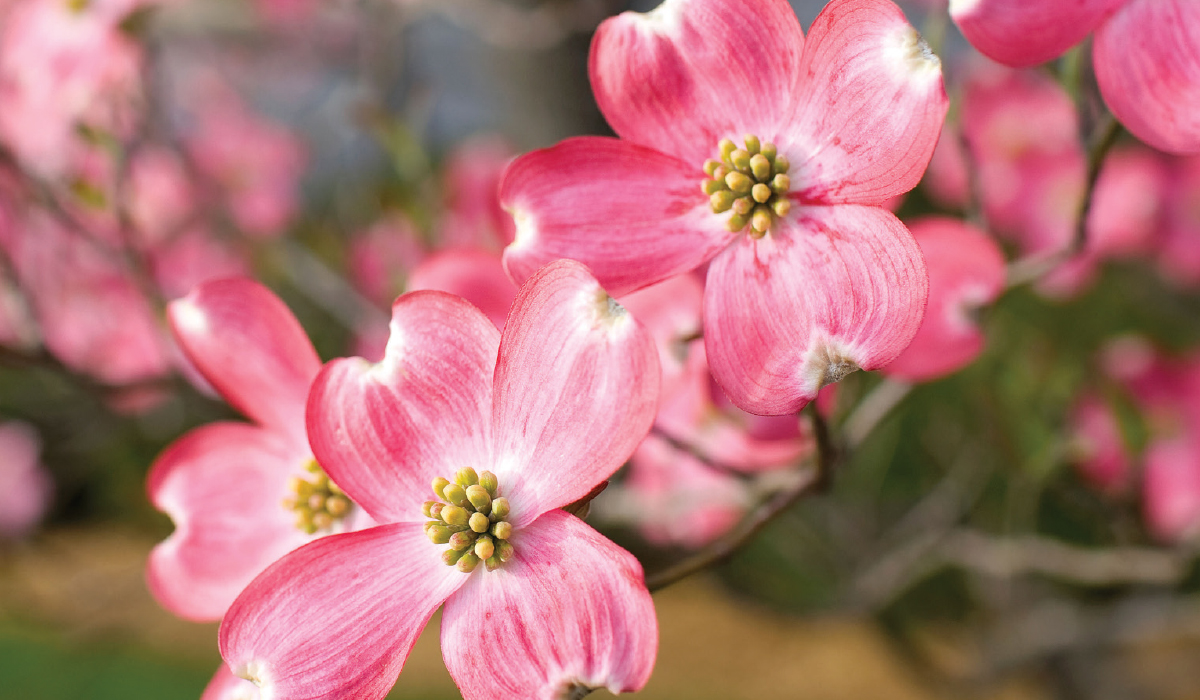
Florida Dogwood ‘Cherokee Brave’
Cornus florida
Cornus florida is considered by many to be one of the most beautiful small ornamental trees. Native to the East Coast of the US, it offers so much to the gardener. It blooms in early spring, usually mid to late April and into May, before the leaves appear. The true dogwood flowers are actually tiny, yellowish green button-like clusters. However, each flower cluster is surrounded by four showy petal-like bracts which open flat, giving the appearance of a single, large, 4-petaled flower. Oval, dark green leaves, turn attractive shades of red in fall and hold that color for a long period of time. An added bonus in late summer and into the fall are the bright red fruits, bitter tasting to us but much loved by the birds. Cornus florida typically grows 15’-20’ tall with a low-branching, broadly-pyramidal habit. Varieties to consider include ‘Cherokee Brave’, ‘Cherokee Princess’ and ‘Rubrum’.
KOUSA DOGWOOD
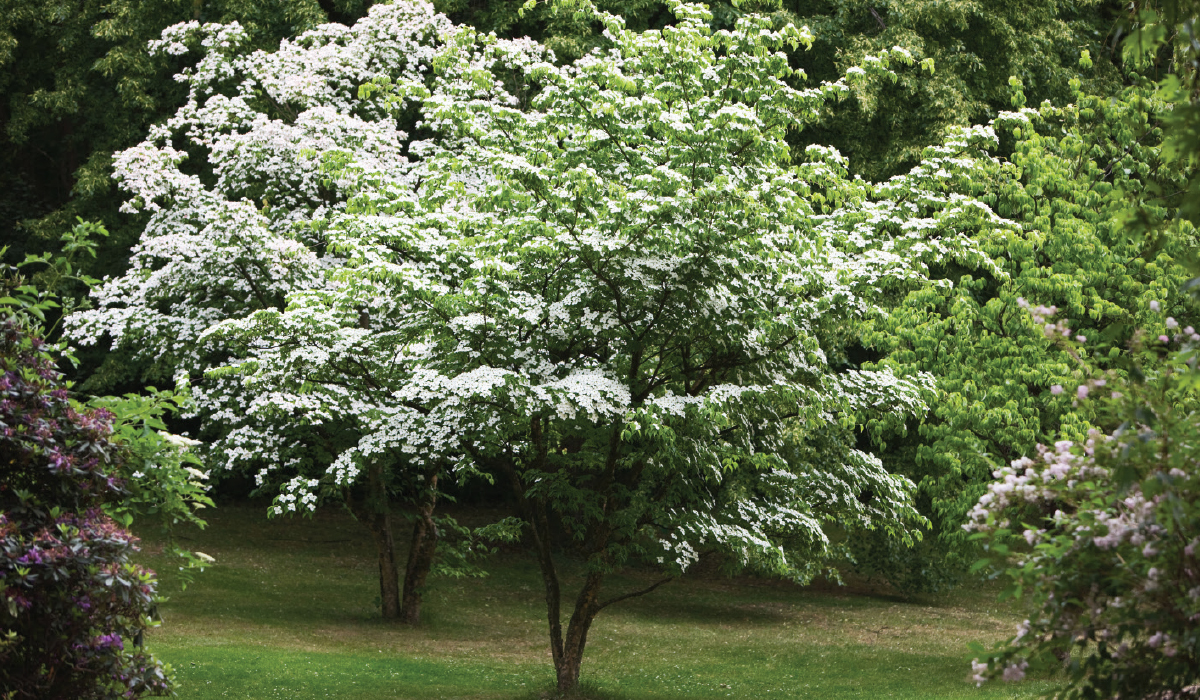
Kousa Dogwood, one of the few flowering trees to bloom in June.
Cornus KOUSA
The leaves of Cornus kousa emerge in spring, followed in early summer by star-shaped white blossoms. One of the few trees to bloom in June! Red fruits form in late summer and have an interesting knobby texture. They attract birds and persist through the autumn. The leaves turn rich colors of red, orange and scarlet in the fall. They eventually drop to reveal the tree’s distinctive horizontal branching pattern and mottled tan/grey bark. Among the many varieties of Cornus kousa are ‘Galilean’, ‘Heart Throb’, ‘Milky Way’, and ‘National’.
Cornus x Rutgan ‘Stellar Pink’
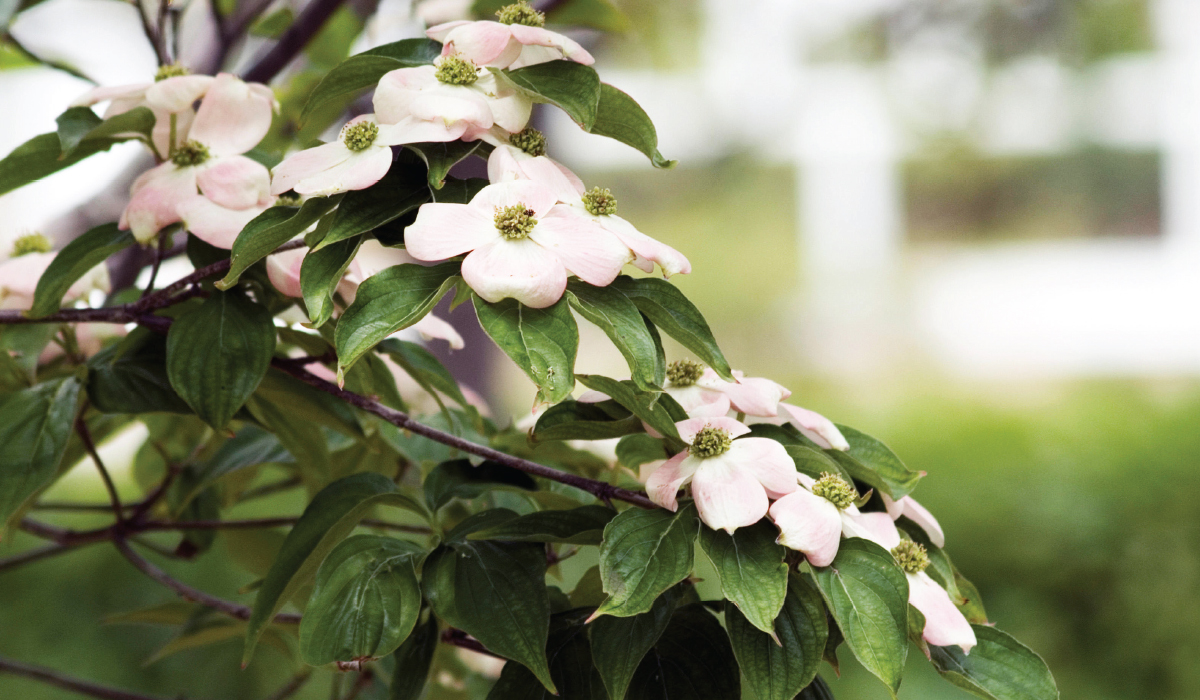
Cornus x Rutgan ‘Stellar Pink’
The breeding program at Rutgers University has produced Dogwoods which are a cross between Cornus florida and Cornus kousa. They bloom after the Cornus florida varieties, but before the Kousa varieties. The variety ‘Stellar Pink’ has profuse, large, overlapping, blush pink floral bracts. Its dense branching habit provides layers of lush green foliage from bottom to top. This is a vigorous cultivar with an erect habit. The Rutgers hybrids are sterile and thus, do not set fruit.
MAGNOLIA
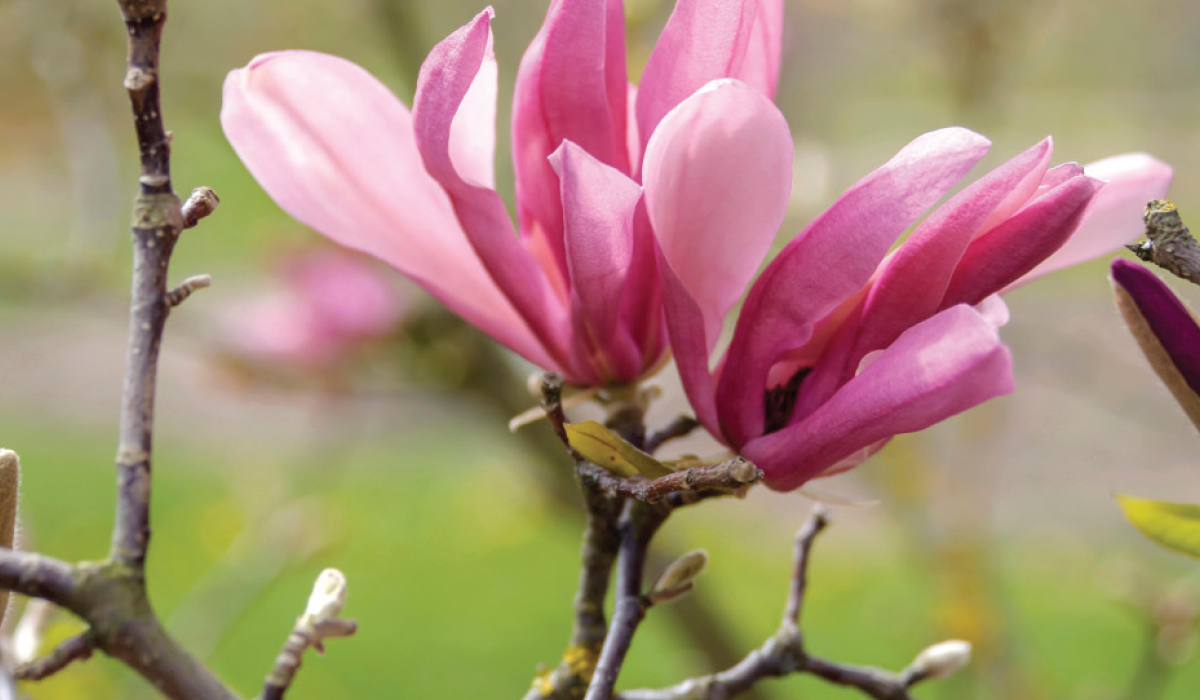
Magnolia ‘Ricki’
Nothing says spring in Boston like the Magnolias that line Commonwealth Avenue. Whether you choose a Saucer-type Magnolia like those on Comm Ave or a Star Magnolia with its multi petaled flowers, you will enjoy a spring show like no other. Some varieties grow in tree form, others as multi-trunked shrubs. All display fat, fuzzy buds through the winter, offering promise of the spring to come. They are best sited in a protected location to avoid a late frost which might damage emerging flowers. No matter what type of Magnolia you choose, it will add a natural grace in the garden.
Magnolia stellata (the Star Magnolia) is distinguished by its showy, fragrant white flowers that have a pink tinge. Each flower has 12 to 18 petals. Seeing them dance in the wind is a delight. The variety that most closely resembles the classic Saucer Magnolia is Magnolia ‘Jane’ with its 8 inch cup shaped flowers. It blooms slightly later than the classic Saucer Magnolia, thereby reducing the possibility of late season frost damage. Flowers bloom sporadically during the summer, extending its season of beauty. Other varieties to consider include ‘Leonard Messel’, ‘Ann’, ‘Butterflies’ ‘, Elizabeth’ and ‘Ricki’.
FLOWERING CRABAPPLE
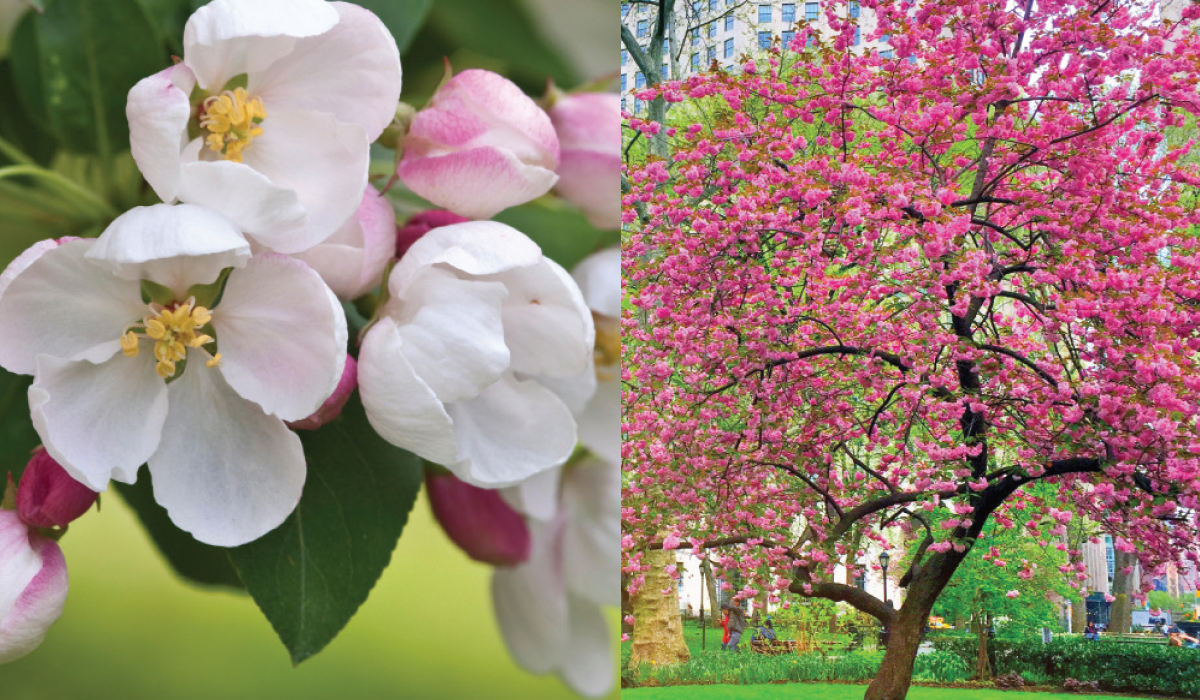
Left: ‘Donald Wyman’, Right: ‘Prairiefire’
MALUS
Flowering Crabapples are beautiful contributors to the landscape in all four seasons of the year. In spring, they offer delicate colors in their emerging leaves and flower buds. While unopened flower buds may hint of one color, other hues are revealed as the flowers open. As flowers fade, the rich foliage offers another subtle contribution to the landscape. Then, as leaves drop in the late autumn, the colorful fruit takes center stage. And with a dusting of snow to accent the fruit and the sculptural qualities of the tree branches, it presents an unrivaled winter picture. Today’s varieties are disease-resistant and easy to grow. Varieties to consider include ‘Camelot’, ‘Donald Wyman’, ‘Prairiefire’ and ‘Royal Raindrops’.
FLOWERING CHERRY

Kwanzan Cherry
PRUNUS
Available in upright tree form and weeping varieties, flowering Cherries are some of the loveliest spring flowering trees. Iconic images of the Cherry Blossom Festival in Washington, DC come to mind when we think of flowering Cherries. Prunus x yedoensis, commonly called Yoshino Cherry, has fragrant flower clusters that emerge pale pink and fade to white, creating a profuse and spectacular early spring show. This hybrid Cherry comes from Japan and is the predominant Cherry tree planted in Washington D.C, enjoyed during the Cherry Blossom Festival each year.
Prunus serrulata ‘Kwanzan’ has particularly pretty, double-pink blossoms which are especially long lasting. It blooms a couple of weeks later than the Yoshino Cherry. Its upright, vase-shaped branching habit makes it a lovely specimen. In addition to these upright growing varieties, flowering Cherries are available in a beautiful weeping form. Look for the weeping Higan Cherry and the weeping Snow Fountain Cherry to add a sense of elegance to the garden.
FLOWERING PLUM

Plum ‘Thundercloud’
Prunus cerasifera
Modern cultivars of this tree offer a color palette that set them apart from other trees in the ornamental landscape. The varieties ‘Thundercloud’ (pictured above) and ‘Krauter Vesuvius’ both have a profusion of flowers that blanket the stems in spring and have showy purple toned foliage that retains its color throughout the growing season.

